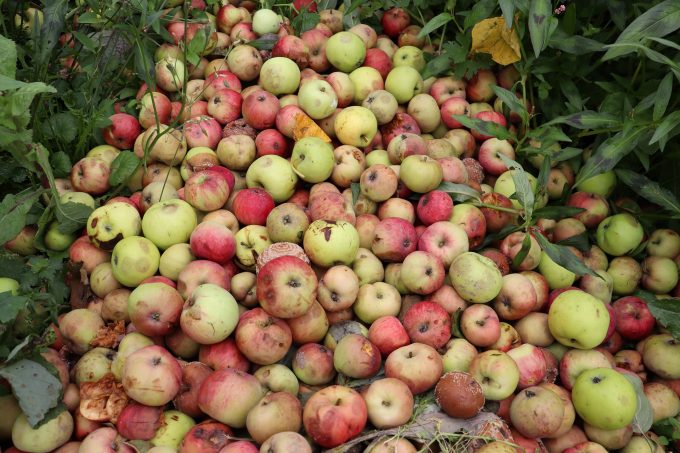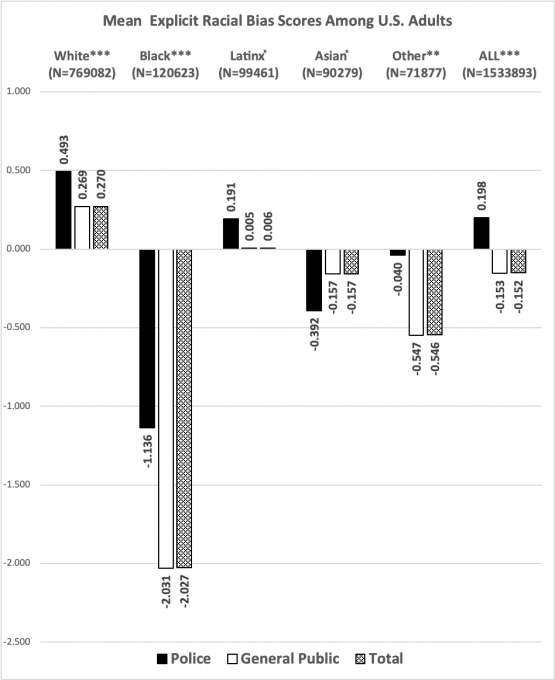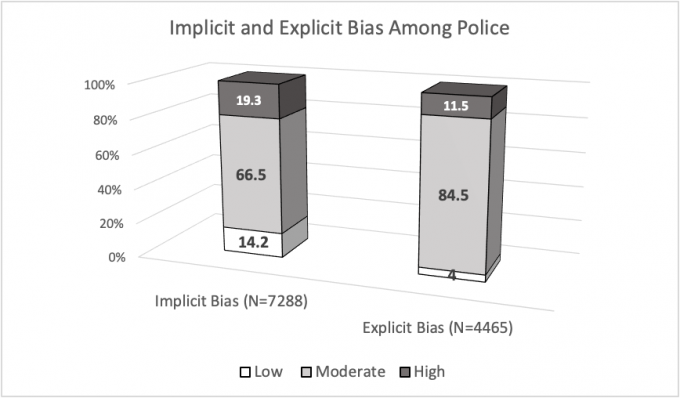How Many Bad Apples? Investigating Implicit and Explicit Bias Among Police Officers and the General Public

Research shows that Blacks and Latinos are much more vulnerable to police misconduct than whites. Cell phone videos of Black individuals being the victim of excessive force—including deadly force—at the hands of (white) officers is seemingly becoming all too common. Yet, even with video evidence, many whites still attribute these incidents of extrajudicial violence to the actions of a few “bad apples.” Indeed, White House national security advisor Robert O’Brien recently suggested that there are “a “few bad apples that are giving law enforcement a terrible name,” while at the same time asserting “…I don’t think there’s systemic racism.” While the “bad apples” trope–which infers that police misconduct is a consequence of individual prejudice among a small handful of officers–is not uncommon, there is a growing recognition that police brutality may also reflect a form of systemic racism embedded in the structure and culture of police departments. Notwithstanding the systemic racism perspective, the purpose of this study is to examine the issue of racial bias among police.
Are police officers biased?
Activists, scholars, politicians, and even members of the public have claimed that the disproportionate amount of force exhibited by white officers against minority citizens is due to either explicit (conscious) or implicit (unconscious) bias. Not surprisingly, the calls for police reform that have grown since the killing of George Floyd often include changes to use-of-force policies and notably implicit bias training for officers. An understanding of bias among officers could help both police officer recruitment and training.
While many studies have examined public attitudes toward the police, and the links between police bias and use of force, racial profiling, and civilian deaths, we found no research examining the extent of racial bias among the police. One study compared racial attitudes of police with same race members of the public. Using data from both the General Social Survey and the National Election Survey, LeCount (2017) found that police were more biased (on multiple indicators) than non-police, among whites, but not among blacks. However, these findings did not address the underlying question of how widespread racial bias may be among the police. Fortunately, data from Project Implicit (Xu et al., 2014) provides relevant information to address this issue. While the Project Implicit respondents are not a random nor representative population sample, the data do allow us to evaluate explicit and implicit bias for a large sample (roughly 4.8 million U.S. adults including nearly 8,000 police) and provides a good baseline for future studies.
Implicit Bias
The Implicit Association Test (IAT) is one of the most widely used and one of the most internally reliable measures of implicit attitudes. The Black-White IAT used in this study reflects biases in how quickly and accurately respondents can pair White faces with “good” words and Black faces with “bad” words in comparison to the inverse. The IAT is scored by subtracting the mean reaction times when Black is paired with good from the mean reaction times when White is paired with good and dividing that difference by the pooled standard deviation of reaction times on Black-good and White-good blocks (see Greenwald et al., 2003). Negative scores indicated pro-Black/anti-White bias, and positive scores indicated pro-White/anti-Black bias, with distance from zero indicating magnitude of the bias.
For each major race-ethnic group, Figure 1 reports mean implicit bias scores overall, for both the police and the general public. Compared to the public, police exhibit (significantly) higher levels of implicit (pro-White/anti-Black) bias overall, as well as among Whites, Blacks, and Other racial groups. Among Latinx, this difference is nominally significant.
We observe higher levels of implicit bias among Whites than Black, Asian, Latinx, and other race groups. However, each of the other race-ethnic groups (Asian, Latinx, Other) except Blacks also exhibit relatively high levels of implicit (pro-White/anti-Black) bias. Notably, among Blacks, police exhibit a slight (pro-White/anti-Black) attitude while members of the public exhibit the opposite-a slight (pro-Black/anti-White) sentiment. This finding raises questions about whether there is something about the police profession that can explain this contrast. Do people choosing to become police officers already hold such views? Does law enforcement itself somehow instill such perceptions? Or perhaps, it is some combination of both. Unfortunately, with the limited set of demographic measures available in the Project Implicit data we are unable to disentangle selection factors from socialization factors.

Explicit Bias
We measure explicit bias by subtracting participants’ reported warmth toward Black people from their reported warmth toward White people, both assessed on a 0 to 10 scale (0 = very cold, 10 = very warm). Higher values indicate more warmth toward White people compared to Black people.
For each major race-ethnic group, Figure 2 reports mean explicit bias scores overall, for police, and for the public.

The results are strikingly different: even though compared to the public, police also report significantly higher levels of explicit bias, Whites, overall, exhibit much higher levels of explicit bias than other racial groups. Additionally, among Whites, police display higher levels of explicit bias than other ingroup members. Although Blacks exhibit much lower levels of explicit bias than other racial groups, Black police display greater explicit bias than other ingroup members. Latinx individuals are the only group other than Whites exhibiting explicit bias. Although police display generally higher levels of explicit bias than other members of the Latinx community, this difference is not statistically significant. Taken together, these findings reflect the limitations of diversification of police forces as one mode of reform—among many other potential reforms. Police, of course, should reflect the communities they are policing, but this analysis provides some hints as to why deep, structural reform is necessary—but minority representation should not be considered a panacea.
How Many Bad Apples?
To address the extent of racial bias among the police, we compare the proportion of police who are low (one standard deviation below the sample mean) and high (one standard deviation above the sample mean) on both implicit and explicit bias. Individuals who fall between those boundaries are categorized as exhibiting moderate levels of implicit bias.

Figure 3 shows that the overwhelming majority of police fall into the moderate category on both the implicit (67%) explicit (85%) bias measures. While 14% of police rank low in implicit bias, and 4% rank low in explicit bias, almost one of five officers (19%) exhibit high levels of implicit bias and roughly one of eight police (12%) exhibit high levels of explicit bias. These figures signal that there are more than a “few” potential bad apples. Although police with strong racial bias may not engage in violent interactions with minorities, their bias could potentially shape other types of encounters, including traffic stops or decisions to render assistance. These biases may also influence the culture of police departments in ways that pose challenges for Black or Latinx officers.
Is the Orchard Infected?
These findings portray alarming levels of both implicit and explicit bias among Project Implicit respondents who serve as police officers. We find that officers exhibit consistently higher levels of bias than members of the public overall, and compared to other members of their own racial groups. The level of implicit bias among police is perhaps not surprising because it is fairly widespread. However, the extent of explicit bias found among police is both surprising and alarming.
Police bias of any type is consequential for the citizens they serve, especially today in light of 21st century policing efforts, built on a bedrock of trust and legitimacy. Studies have documented how police disposition affects outcomes in virtually all types of civilian encounters: investigatory traffic (and even bicycle) stops, stop-and-frisk practices, drug arrests, etc. The extensiveness of these types of racially disparate treatment of Black and Latinx citizens suggests that there may be not a few, but many, bad apples among the police.
Addressing Racial Bias Among Police
While this is a study of police bias, it is important to point out that “police are people too.” In a “racialized society”, it is not surprising we find that both police and members of the public hold pro-White explicit and implicit racial biases; however, the differences between the levels of bias in many instances, are alarmingly substantial. Our findings suggest that if police-community relations are to significantly improve, the police must be trained to either shift or mitigate the effects of their own racial biases and that such training must be an ongoing series of exercises that challenge officers to confront those biases. Although a small number of police may be responsible for a disproportionate number of misconduct incidents, the mistreatment of Black people appears to be embedded within, and legitimated by, a collective, organizational culture characterized by anti-Black prejudice. Therefore, training programs must focus not only on changing officers’ individual biases, but transforming shared beliefs about race. This can only be accomplished when race-awareness is considered a fundamental component of police training and professional development, and not simply a task to be “checked off.”
Police organizations can be proactive in preventing excessive force against people of color by creating improved selection criteria for new recruits. While a lack of racial diversity may be a valid criticism in many departments, our findings suggest that workforce diversification alone will not fix the problem of racial inequality in policing. The IAT could be used to screen recruits for implicit and explicit biases either before hiring, or before active duty assignment. In either case, officers with elevated levels of bias should not be allowed on patrol, as they pose a particular risk to people and communities of color. Implementing such a policy could not only be helpful in mitigating police violence and misconduct, it would also symbolize a commitment to racial justice.
Recommended Reading
Racial Bias in Policing: Why We Know Less Than We Should. Goff, P.A., & Kahn, K.B. Social Issues and Policy Review, 2012
Final Report of the President’s Task Force on 21st Century Policing 2015
Implicit Bias and Policing Spencer, K.B., Charbonneau, A.K., & Glaser, J. Social and Personality Psychology Compass, 2016
Organizational, administrative, and environmental correlates of complaints about police use of force: does minority representation matter? Hickman, M. J., & Piquero, A. R. Crime & Delinquency 2009
Bad apples? Attributions for police treatment of African Americans. Haider‐Markel, D.P. and Joslyn, M.R., Analyses of Social Issues and Public Policy, 2017.
Jomills H. Braddock, II is Professor of Sociology at the University of Miami. Rachel E. Lautenschlager is an Assistant Professor in the Department of Sociology and Criminology at the University of Denver. Alex R. Piquero is Professor and Chair of the Department of Sociology and Arts & Sciences Distinguished Scholar at the University of Miami and Professor of Criminology at Monash University in Melbourne, Australia. Nicole Leeper Piquero is a Professor of Sociology at the University of Miami.
(For further information about this research, contact Alex R. Piquero at axp1954@miami.edu)

Comments 3
Will
October 27, 2020The authors say, "we found no research examining the extent of racial bias among the police." I am not sure why, so let me help.
1) Worrall et al. (2018) in Crime and Delinquency. The authors conclude: "Findings suggest that Black suspects were not disproportionately the target of police shootings; Black suspects were approximately one third as likely to be shot as other suspects. This finding challenges the current bias narrative and is consistent with the other race-related findings in recently published research."
2) Fryer (2016) in the Journal of Political Economy. An infamous study, curiously omitted, where examination of lethal force showed "no racial differences in either the raw data or when contextual factors are taken into account."
3) Johnson et al. (2019) in PNAS. Another infamous study, curiously also omitted from consideration here, where the authors concluded, "We find no evidence of anti-Black or anti-Hispanic disparities across shootings, and White officers are not more likely to shoot minority civilians than non-White officers."
4) Correll et al. (2007) in the Journal of Personality and Social Psychology. Another big one comparing trained officers and civilians in "shoot/don't shoot" simulations where the authors found that while "[b]oth samples exhibited robust racial bias in response speed...Officers outperformed community members on a number of measures, including overall speed and accuracy. Moreover, although community respondents set the decision criterion lower for Black targets than for White targets (indicating bias), police officers did not. The authors suggest that training may not affect the speed with which stereotype-incongruent targets are processed but that it does affect the ultimate decision." That's a fascinating finding. Why pretend a doesn't exist?
5) Apparently M.A. students are also better at carefully addressing the present topic. Here Adank (2017) conducted a "shoot/don't shoot" study examining implicit bias, albeit not among officers, and concluded this: "Although not statistically significant, an analysis of the raw numbers of incorrect shots may suggest that participants were more likely to make a mistake (whether Type I or II Error) when the person in the scene was White rather than Black. Popular media would suggest that the unarmed black male would be shot the most, but this study’s sample population has suggested other results."
That should get the authors started. I think the authors of the present article need to go back to the drawing board and conduct a proper literature review. The claim that there isn't any published work on racial biasing in policing is astonishingly false. More than that, it is reckless, maybe even malpractice, given the importance of the topic and how charges of "systemic racism" in policing made by scientific "authorities" are certainly not helping skyrocketing murder rates in Black communities in some of our big urban centers. Think about the irony of that.
Ray
October 28, 2020Black people are 3.5 times more likely than Whites to be killed by police when they are not attacking or have a weapon. This speaks to implicit bias in policing. Feel free to cite anything that I written recently. You should also do some more work on the articles you note above. Some have been retracted and others haven't gotten past peer review.
James
December 1, 2020Got it, Ray. So the tune changes now. Before no research existed. Now it does, but it's just no good. This is exactly how cults work. In fact, the volume of work does not support the sociological narrative. Period. And as far as the retraction goes, that was forced by the cult. The authors stand by their analysis. Not surprising you omit that critical point. When the facts don't fit the narrative, suppress the facts and double down on your position. That is modern sociology. Confirmation bias and sanctimony combined are cancer to a discipline.